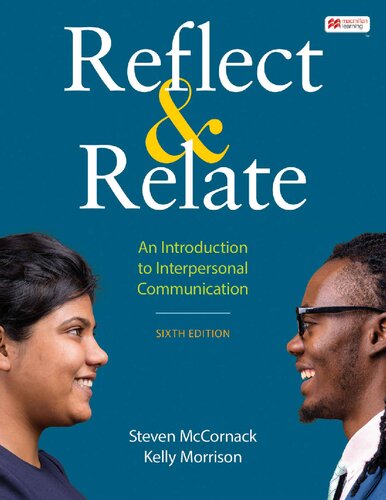Reflect & Relate: An Introduction to Interpersonal Communication 6th Edition by Steven McCornack, ISBN-13: 978-1319247584
[PDF eBook eTextbook]
- Publisher: Bedford/St. Martin’s; Sixth edition (November 2, 2021)
- Language: English
- ISBN-10: 131924758X
- ISBN-13: 978-1319247584
Current, inclusive, and authoritative, Reflect & Relate, Sixth Edition, has set the new standard for interpersonal communication texts. Steve McCornack and Kelly Morrison, both distinguished scholars and award-winning teachers, draw on their twenty-five years of classroom experience to connect classic and current communication theory and research to the actual lives of today’s students.
For the sixth edition, the authors built on their leading gender coverage by partnering with an advisory board of culturally responsive-sustaining pedagogy leaders to create an even more inclusive text that models for and guides students in culturally self-aware and inclusive communication. The revision features over 300 new scholarly citations, and responds to the real and growing interpersonal challenges students currently face: how to form positive relationships to support health and wellness, within increasingly online contexts, and with people who have a variety of backgrounds, abilities, and experiences. Additionally, coverage of mediated communication—its advantages, as well as its challenges—has been thoroughly updated to support students in today’s digital world.
Table of Contents:
About this Book
Cover Page
Inside Front Cover
Making Relationship Choices videos take communication to the next level
Accessibility
Title Page
Copyright Page
Reflect & Relate, Sixth Edition, connects to the learning outcomes of the National Communication Association (NCA)
Preface
Brief Contents
Contents
The Editorial Board
The Authors
Chapter 1 Introducing Interpersonal Communication
What Is Communication?
Defining Communication
Understanding Communication Models
What Is Interpersonal Communication?
Defining Interpersonal Communication
Principles of Interpersonal Communication
Motives for Interpersonal Communication
What Is Interpersonal Communication Competence?
Understanding Competence
Improving Your Mediated Communication Competence
Issues in Interpersonal Communication
Culture
Focus on Culture: What Does Culture Mean to You?
Gender and Sexual Orientation
Technologically Mediated Communication
Challenging Issues in Interpersonal Relationships
The Journey Ahead
Making Relationship Choices: Dealing with a Difficult Friend
Chapter Review
Key Terms
Key Concepts
Chapter 2 Considering Self
The Components of Self
Self-Awareness
Self-Concept
Self-Esteem
Focus on Culture: How Does the Media Shape Your Self-Esteem?
The Sources of Self
Gender and Self
Family and Self
Culture and Self
Communicating Your Self
Maintaining Your Public Self
Disclosing Your Private Self
The Relational Self
Competently Disclosing Your Self
The Social Media Self
Self-Presentation on Social Media
Evaluating Social Media Self-Presentations
Improving Your Social Media Self-Presentation
Improving Your Self
Making Relationship Choices: Workplace Self-Disclosure
Chapter Review
Key Terms
Key Concepts
Chapter 3 Perceiving Others
Perception as a Process
Selecting Information
Organizing the Information You’ve Selected
Interpreting the Information
Reducing Uncertainty
Influences on Perception
Perception and Culture
Perception and Gender
Perception and Personality
Forming Impressions of Others
Constructing Gestalts
Calculating Algebraic Impressions
Stereotyping
Focus on Culture: Intersectional Stereotyping and U.S. Folk Music
Improving Your Perception
Offering Empathy
Checking Your Perception
Practicing Responsible Perception
Making Relationship Choices: Balancing Impressions and Empathy
Chapter Review
Key Terms
Key Concepts
Chapter 4 Experiencing and Expressing Emotions
The Nature of Emotion
Defining Emotion
Feelings and Moods
Focus on Culture: Happiness across Cultures
Types of Emotions
Forces Shaping Emotion
Personality
Gender
Managing Your Emotional Experience and Expression
Emotional Intelligence
Managing Emotions after They Occur
Preventing Emotions before They Occur
Reappraising Emotions while They Occur
Emotional Challenges
Anger
Text-Based Online Communication and Empathy Deficits
Passion
Grief
Living a Happy Emotional Life
Making Relationship Choices: Managing Anger and Providing Support
Chapter Review
Key Terms
Key Concepts
Chapter 5 Understanding Culture
Understanding Culture
Culture Defined
Co-Cultures
Co-Cultures and Communication
Focus on Culture: Is Social Media a Cultural Divide?
Prejudice
Cultural Influences on Communication
Individualism Versus Collectivism
Uncertainty Avoidance
Power Distance
High and Low Context
Emotion Displays
Masculinity Versus Femininity
Views of Time
Creating Intercultural Competence
World-Mindedness
Attributional Complexity
Communication Accommodation
Dismantling Divisions
Making Relationship Choices: Parent—Child Culture Clash
Chapter Review
Key Terms
Key Concepts
Chapter 6 Understanding Gender
Understanding Gender
Gender is Distinct from Sex and Gender Identity
Gender is Learned
Gender is Socially Constructed
Doing Gender
Considering Gender Roles
Gender and Communication
Focus on Culture: Gender Equity and Health
Gender and Verbal Communication
Gender and Nonverbal Communication
Gender and Relationships
Friendships
Romantic Relationships
Reflecting on Gender in Our Relationships
Moving Beyond Gender Stereotypes
Making Relationship Choices: Supporting a Gender-Nonconforming Friend
Chapter Review
Key Terms
Key Concepts
Chapter 7 Listening Actively
Listening: A Five-Step Process
Receiving
Attending
Understanding
Responding
Recalling
The Five Functions of Listening
Listening to Comprehend
Listening to Discern
Listening to Analyze
Listening to Appreciate
Focus on Culture: The Therapeutic Power of Listening to Music
Listening to Support
Adapting Your Listening Purpose
Listening Functions and Mediated Listening
Understanding Listening Styles
Four Listening Styles
Gender and Listening
Culture and Listening
Improving Listening Competence
Selective Listening
Eavesdropping
Pseudo-Listening
Aggressive Listening
Narcissistic Listening
The Gift of Active Listening
Making Relationship Choices: Listening When You Don’t Want To
Chapter Review
Key Terms
Key Concepts
Chapter 8 Communicating Verbally
Describing Verbal Communication
Language is Symbolic
Language is Governed by Rules
Language is Flexible
Language is Cultural
Language Evolves
Functions of Verbal Communication
Sharing Meaning
Shaping Thought
Naming
Focus on Culture: Adopting Gender-Inclusive Language
Performing Actions
Crafting Conversations
Managing Relationships
Cooperative Verbal Communication
Understandable Messages
Using “I” Language
Using “We” Language
Barriers to Cooperative Verbal Communication
Verbal Aggression
Deception
Defensive Communication
Communication Apprehension
The Power of Verbal Communication
Making Relationship Choices: Dealing with Difficult Truths
Chapter Review
Key Terms
Key Concepts
Chapter 9 Communicating Nonverbally
Describing Nonverbal Communicationn
Nonverbal Communication Differs from Verbal Communication
Nonverbal Communication is Influenced by Culture
Nonverbal Communication is Influenced by Gender
Nonverbal Communication is Liberated and Challenged by Technology
Nonverbal Communication Codes
Communicating through Body Movements
Communicating through Voice
Communicating through Touch
Focus on Culture: Touch and Distance
Communicating through Personal Space
Communicating through Physical Appearance
Communicating through Objects
Communicating through the Environment
Functions of Nonverbal Communication
Expressing Emotion
Conveying Meanings
Presenting Self
Managing Interactions
Defining Intimacy
Competently Managing Your Nonverbal Communication
Making Relationship Choices: Dealing with Mixed Messages
Chapter Review
Key Terms
Key Concepts
Chapter 10 Managing Conflict and Power
Conflict and Interpersonal Communication
What is Conflict?
Conflict in Relationships
Power and Conflict
Power’s Defining Characteristics
Power Currencies
Power and Gender
Handling Conflict
Approaches to Handling Conflict
Culture and Handling Conflict
Focus on Culture: Accommodation and Radical Pacifism
Handling Text-Based Conflict
Conflict Endings
Short-Term Conflict Resolutions
Long-Term Conflict Outcomes
Challenges to Handling Conflict
Self-Enhancing Thoughts
Destructive Messages
Serial Arguments
Physical Violence
Unsolvable Disputes
Managing Conflict and Power
Making Relationship Choices: Dealing with Family Conflict
Chapter Review
Key Terms
Key Concepts
Chapter 11 Relationships with Romantic Partners
Defining Romantic Relationships
Liking and Loving
Different Types of Romantic Love
Key Elements of Romantic Relationships
Romantic Attraction
Proximity
Physical Attractiveness
Similarity
Reciprocal Liking
Resources
Technology and Romantic Attraction
Focus on Culture: Romance and People with Disabilities in Pop Culture
Relationship Development and Deterioration
Coming Together
Coming Apart
Maintaining Romantic Relationships
Maintenance Strategies
Maintaining Romance Across Distance
Deciding Whether to Maintain
Romantic Relationship Challenges
Betrayal
Jealousy
Relational Intrusion
Intimate Violence
The Hard Work of Successful Love
Making Relationship Choices: Managing Jealousy about a Partner’s Ex
Chapter Review
Key Terms
Key Concepts
Chapter 12 Relationships with Family Members
Defining Family
Defining Characteristics of Family
Types of Families
Family Stories
Communicating in Families
Communication Dimensions
Family Communication Patterns
Maintaining Family Relationships
Maintenance Strategies for Families
Technology and Family Maintenance
Dealing with Family Dialectics
Focus on Culture: Autonomy and Connection: Helicopter and Snowplow Parents
Family Relationship Challenges
Stepfamily Transition
Parental Favoritism
Interparental Conflict
The Primacy of Family
Making Relationships Choices: Struggling with Family Transitions
Chapter Review
Key Terms
Key Concepts
Chapter 13 Relationships with Friends
The Nature of Friendship
Friendship Defined
Friendship Functions
Friendship Across the Life Span
Friendship, Culture, and Gender
Friendship and Technology
Focus on Culture: Broadening Diversity of Friends through Social Media
Types of Friendships
Best Friends
Active, Dormant, and Commemorative Friends
Maintaining Friendships
Following Friendship Rules
Maintenance Strategies for Friends
Friendship Challenges
Betrayal
Geographic Separation
Attraction: Romance and FWB Relationships
The Importance of Friends
Making Relationship Choices: Choosing between Friends
Chapter Review
Key Terms
Key Concepts
Chapter 14 Relationships in the Workplace
The Nature of Workplace Relationships
The Culture of the Workplace
Networks in the Workplace
Organizational Climates
Technology in the Workplace
Peer Relationships
Types of Peer Relationships
Maintaining Peer Relationships
Mixed-Status Relationships
Managing Up
Communicating with Employees
Focus on Culture: The Model Minority Myth
Challenges to Workplace Relationships
Workplace Bullying
Workplace Romances
Sexual Harassment
Workplace Relationships and Human Happiness
Making Relationship Choices: Dealing with Workplace Abuse
Chapter Review
Key Terms
Key Concepts
Glossary
References
Name Index
Subject Index
Notes
Extended Descriptions
The front cover of the book book Reflect & Relate, Sixth Edition, Steven McCornack and Kelly Morrison.
A photo shows six women dancing together on a circular glass platform, with forested mountains in the background.
A photo shows Supreme Court justices Ruth Bader Ginsburg and Antonin Scalia standing together as part of a large audience.
Interpersonal communication is the bridge that connects us to others.
A photo shows a family (mother, father, son, and daughter) gathered around a dining-room table in a clean, modern, and spacious apartment. A bowl filled with fruit is on the table
Figure 1.1 Communication Technologies Used by U.S. Young Adults, Ages 18 to 29
A screenshot from a LaunchPad video shows two women standing and facing each other
Figure 1.2 Linear Model of Communication
Figure 1.3 Interactive Model of Communication
Figure 1.4 Transactional Model of Communication
When we interpersonally communicate, we forge meaningful bonds with others.
A photo shows three women buying produce in a large indoor market
A photo shows a man and woman sitting on a sofa
A collage of four photos in a 2-by-2 grid. Each photo focuses on 2 people doing something together
By deepening your self-understanding, you can begin to clarify your thoughts and feelings about your self.
A screenshot from a LaunchPad video shows two young men talking by a water cooler
A screenshot from a LaunchPad video shows two women in a room with a row of folding chairs
Figure 2.1 Low Self-Esteem: A Vicious Cycle
A photo shows a young woman sitting on a ledge and taking a picture
Three photos illustrate the concepts of gender, family, and culture
Figure 2.2 Avoidance and Anxiety in Attachment Styles
Two photos show athletes engaging in a political protest
A photo shows Rick Welts kneeling on one knee and holding a basketball
A movie still shows a young woman putting her hand on the shoulder of an older woman, as if comforting her
Figure 2.3 The Layers of Self
Figure 2.4 The Johari Window
A photo shows a man holding a metal implement
A photo shows President Barack Obama sitting in a chair
We rely on perception constantly to make sense of everything and everyone in our environment.
Figure 3.1 The Process of Perception
A screenshot from a LaunchPad video shows two young men sitting on a sofa with an older man leaning on the back of the sofa behind them
A photo shows a young woman sitting at a desk with other people in an office setting
Three photos illustrate learning about people by observing them, by asking about them, or by interacting with them directly
A photo shows four people on a sailboat, leaning on a boom
An illustration shows six cartoon characters standing side by side
Two photos of Malcolm X
A photo shows two young women sitting together on a sofa
Figure 4.1 The Flow of Emotions, Feelings, and Moods
A photo shows a man exercising
Four photos of people’s faces in circular frames, arranged in a row, Two photos express human emotions
A still from Bridesmaids shows six women walking down a corridor
A photo shows a little girl sitting at a table with a marshmallow on a plate in front of her
A photo shows a young man and a young woman standing in a kitchen, facing each other
Two photos, placed side by side, show people sitting next to each other
A photo shows a woman dressed in a sari kneeling next to the outstretched arm of a person who is not visible in the photo
A screenshot from a LaunchPad video shows two women sitting on a sofa and holding coffee mugs
We create joy—through every decision we make and every thought, word, and deed.
A grid of 4 photos illustrates 4 different cultural traditions
A photo shows an elderly white woman standing next to a young black man who has his right arm around her shoulders
A screengrab from a LaunchPad video shows a young man and two young women in a living room
Two photos side by side illustrate the difference between individualistic and collectivistic cultures
Figure 5.1 Power Distance across Countries
Figure 5.2, “Comparing Masculine and Feminine Cultural Values in the United States and Sweden,” consists of a bar graph and a table
A still from a movie shows Clint Eastwood standing around a food-laden table with 3 Asian people—a middle-aged man and woman, and a young woman
A photo shows two images of “Merida” side by side
Three side-by-side photos of notable transgender people show, left to right, Jazz Jennings, Danica Roem, and Kylar Broadus
A photo shows a large gift box on a lawn of green grass
A photo shows a sign for a restroom that is open for everyone, regardless of gender
A photo shows a poster or space ad for the documentary movie The Mask You Live In
A photo shows Tatyana Fazlalizadeh standing
A photo shows the head and chest of Orlando Cruz with his arms raised in a boxing pose
A photo shows a bookstore-type display of books by John Gray
In what ways have you moved past gender stereotypes, both in yourself and in your relationships with others?
Listening is our most primal and primary communication skill.
A photo shows Marlee Matlin speaking and using sign language
A photo shows an elderly woman sitting in a chair and looking at photos
Two side-by-side photos illustrate the difference between dramatic expressiveness and quiet meditation during religious ceremonies
An illustration from a Winnie-the-Pooh book includes many of the main characters
A photo shows David Oyelowo and Ava DuVernay in an outdoor setting
A still from the T V sitcom Schitt’s Creek shows Mayor Roland Schitt and a woman standing side by side
Verbal communication opens doorways to shared understanding, intimacy, and enduring relationships.
A poster shows a portrait painting of a bald man with a full beard and a mustache, wearing spectacles
Figure 8.1 Regional Dialects in the United States
A photo shows an older Muhammad Ali holding a torch on a stage
A photo shows two women standing side by side and talking in a Middle Eastern market
Figure 8.2 Conversational Pattern
A photo shows what appears to be an African scene with 4 young boys and a man in an open area with a tree
A still from a movie shows a middle-aged man talking on a mobile phone
Nonverbal communication powerfully shapes others’ perceptions of you.
We often deduce more meaning from people’s nonverbal rather than verbal communication.
A photo shows a young man sitting on a sofa and looking at a laptop on a coffee table in front of him
A photo shows Tyra Banks sitting with a group of other people
A photo shows an infant and a woman swimming underwater
A screen shot from a LaunchPad video shows two women sitting side by side on a padded bench
A photo shows T-Pain onstage with a man holding a mic
A photo shows a closeup of a circular card held face-up in the palms of two hands
A screen shot from a LaunchPad video shows a young man and a young woman sitting in a row of chairs with an empty chair between them
Figure 9.1 Physical Distance in Communication
A photo shows a young woman and a young man standing in a store
A photo shows Marie Kondo sitting on the floor in a living room
A photo shows Brandi Chastain kneeling on turf and shouting
A photo shows two young men in a parklike setting
Romantic love may not be essential to life, but it may be essential to joy.
A still from the movie Carol shows the characters Carol and Therese sitting together on the floor, in a living room
A photo shows six women dancing together on a circular glass platform, with forested mountains in the background
A photo shows three brothers clowning around together
A photo shows a young man and two toddlers sitting on a lawn covered with fallen leaves
A screenshot from a video clip shows three men sitting around a table and playing cards
A still from the animated movie Avatar: The Last Airbender shows five cartoon characters on a section of the Great Wall of China
Two stills from two different movies illustrate relationships between two friends
In workplace relationships, the professional is profoundly personal.
A photo shows a man and a woman in an office, both wearing pajamas
A photo shows a top view of a woman seated at a wooden table
A still from the T V series Superstore shows a young woman and young man in a supermarket
Three photos show different people expressing their opinion in different platforms
A photo shows Supreme Court justices Ruth Bader Ginsburg and Antonin Scalia standing together as part of a large audience
Videos in LaunchPad
What makes us different?
• Instant Download
• Always Competitive Pricing
• 100% Privacy
• FREE Sample Available
• 24-7 LIVE Customer Support






Reviews
There are no reviews yet.